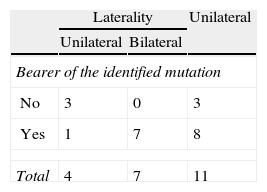To determine the correlation between the presence of genetic anomalies identified in the RB1 gene and the development of trilateral retinoblastoma.
MethodNo patients with primitive neuroectodermal tumor (PNET) were identified out of a total of 206 patients, but there were 17 cases of pineal cysts, of which 11 had a genetic study.
ResultsOf the 11 patients who had a genetic study performed, the anomaly in the germinal line was identified in 8 cases, which was equivalent to 100% of the bilateral retinoblastomas, and 25% of the unilateral ones. It is more common to find a germinal mutation in patients with bilateral disease (p=0.024). There are no significant differences in the type of anomaly identified, although the nonsense-frameshift type is more frequent in cases with bilateral involvement. Identification of the genetic anomaly is more frequent in patients who have pineal cysts (Fisher test; p=0.490). Nine of the 17 patients received systemic chemotherapy (52.29% of the cases), which could be able to prevent the development of PNET. Although a certain trend was observed in all the mentioned parameters, there was a relationship between the presence of pineal cysts and bilateral disease (Pearson Chi χ2: p=0.191), a known family history (Fisher test; p=0.114) and age of early diagnosis (Fisher test; p=0.114). There were no significant differences in the mutation type identified.
ConclusionsConsidering pineal cysts as a pre-malignant form of pinealoblastoma, we found a relationship between the germinal line mutation of the RB1 gene and the cases with bilateral or unilateral retinoblastoma.
Identificar la correlación entre la presencia de alteraciones genéticas identificadas en el gen RB1 y el desarrollo de retinoblastoma trilateral.
MétodoDe un total de 206 pacientes con retinoblastoma, no se identificaron pacientes con tumor neuroectodérmico primario (PNET), pero sí 17 casos de quistes pineales, 11 de los cuales tenían estudio genético.
ResultadosDe los 11 pacientes a los que se les practicó estudio genético, en 8 casos se identificó la alteración en la línea germinal, lo que equivale al 100% de los retinoblastomas bilaterales y al 25% de los unilaterales. Es más frecuente encontrar mutación germinal en los pacientes con enfermedad bilateral (p=0,024). No hay diferencias significativas en el tipo de alteración identificada, aunque el tipo nonsense-frameshift es el más frecuente en los casos con afectación bilateral. La identificación de la alteración genética es más frecuente en los pacientes que presentan quistes pineales (T Fisher p=0,490). Nueve de los 17 pacientes recibieron quimioterapia sistémica (52,29% de los casos), lo que podría abortar el desarrollo de PNET. Aunque en todos los parámetros citados se observa cierta tendencia. Hay asociación entre la presencia de quistes pineales y enfermedad bilateral (Chi cuadrado de Pearson p=0,191): antecedentes familiares conocidos (T Fisher p=0,114) y edad de diagnóstico precoz (T Fisher p=0,114). No hay diferencias significativas en el tipo de mutación identificada.
ConclusionesConsiderando los quistes pineales como una forma premaligna del pinealoblastoma, encontramos una asociación con la mutación de la línea germinal del gen RB1, tanto en casos con retinoblastoma unilateral como bilateral.
Artículo
Comprando el artículo el PDF del mismo podrá ser descargado
Precio 19,34 €
Comprar ahora














